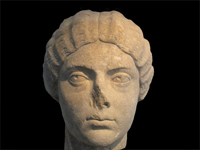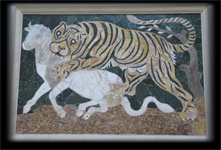ESQUILINO
The Esquilino, as we have said elsewhere, starting from 1870 was the Roman district more profoundly altered with the construction of squares, buildings, the opening of new large street, such as Cavour, Giovanni Lanza, Manzoni street, etc., etc., enlargement of other like Merulana street, the demolition of houses and historic buildings such as the Villa Peretti, built by Pope Sixtus V Felice Peretti, or the Villa Palombara. Then again the excavations to build the new Termini Station and yet the first Roman underground.
Often haste led to the result that of many of the artifacts unearthed we don’t know the exact origin, for example the famous Augustus Labicano: we know of course that was found in Labicana street, but where was it? Inside a Domus (=palace), in Horti Lamiani, in a public building?
Many of the works saved are incredible masterpieces, then to end our visit to the "Regio V Esquiliae", come back to the National Roman Museum, where we see the beautiful portrait of the emperor Tiberius,
one of the best portraits of Hadrian,
then Faustina Minor, wife of Marcus Aurelius to whom gave 13 children and after every childbirth changed hairstyle.
 |
 |
 |
Tiberius |
Hadrian |
Faustina Minor |
Continuing our journey we encounter a goddess accompanied by a small newt.
Now we make an exception to the rule, stopping to look at the Sleeping Hermaphrodite, who having been found beneath the Opera House in a domus (= palace), just Esquilino is not, but almost. Looking at it from one side, soft and seductive are her feminine form, but turning the other side: surprise!
In 1940 in the foundations of a modern building appeared this Apollo named “Liceo”, Roman replica of the Apollo located in Athens “Liceo”, probably the work of the fourth century BC by Praxiteles.
Excavations for the construction of the new central railway station and the layout of the square ahead of the Jubilee of 1950, surfaced the remains of an entire quarter whose frescoes are displayed in the museum.
To crown the Esquilino trip in the National Roman Museum, do not miss the two magnificent tarsia from the Basilica of Junius Basso. One is a procession with a consul and four horsemen; the other depicts the rape of Hylas, one of the Argonauts known for his great beauty, so famous that helped by her companions a nymph abducted him while he was going to fetch water from a source. Note the perfection of the design and the richness of the stones used, the pitcher is mother-of-pearl.
Thanks to the combined ticket (valid for 4 days), we can enter in the nearby Museum of the Baths of Diocletian, where where along the arcades of the Michelangelo courtyard we see an Artemis of the first century AD, the funerary relief of Mary Auxesis, second century AD, a sarcophagus with Cupids Pan and Satyr, perhaps remembering the life of pleasure of the deceased. It follows a beautiful Jupiter bearing on his shoulder a goatskin with the head of the Gorgon.
And finally the portrait of Annia Aurelia Faustina, third wife of Emperor Elagabalus, Severian dynasty, married by Elagabalo to emphasize his ties with Marcus Aurelius, of whom Annia Aurelia Faustina was nephew. Elagabalo for various reasons in Rome was very unpopular, so we can surmise that this marriage has been urged by the capable and powerful grandmother Julia Maesa, who together with the two other Julia: her sister Julia Domna, wife of Septimius Severus, mother of Caracalla and Julia Mamea daughter of Julia Maesa, actually led for twenty years the Roman Empire, as Elagabalus became emperor when was 15 years old and at 19 was killed and his cousin Alexander Severus son of Julia Mamea, when was appointed emperor in 222 he had 13 years.
Alexander Severus was killed in 235 together with his mother during a mutiny of the Germanic legions at which he stood. With him the Severian dynasty extinguished.
His successor was Maximinus Thrax, here we mention him to underline the improbable informations of many ancient sources, notably the famous Historia Augusta tells us that Maximinus Thrax was tall 240 cm and other amenities.
From the Museum of the Baths now we fly to Montemartini, where we can enjoy the Venus replies from Callimaco (fifth century BC). Follows Asclepius,
replica from Fidia, then the beautiful head of Juno replies from Agoracritos of 420 BC.
From an original greek of the fifth century we see the portrait of Perseus or Mercury, Roman replica.
The head of Harmodius is the Roman replica of part of the bronze group depicting tyrannicides, the work of Kritios and Nesiotes built between 475 and 465 BC.
Harmodius and Aristogeiton were said tyrannicides as they removed the Pisistratids to free Athens.
From Tyrannicides pass to the soft Venus of Praxiteles, obviously Roman replica.
Moving on to Isis, Hellenistic work.
The main centers of Hellenism were Pergamum, Rhodes and Alexandria, this Isis is Alexandrian, while belong to the Rhodian school the charioteer head.
Even of Hellenistic school is the head of young crowned with laurel.
Interesting the male head, replica from the first Hellenism, in which the pupil and the iris are made of different material to make it look more alive. This peculiarity makes us understand how the authors of the replicas wanted overcome the originals.
The beautiful Diomede is inspired by an original of the fifth century, full classical era.
Then we arrive at the time of the Antonines emperors to see the portrait of Faustina the Elder, wife of Antoninus Pius and mother of Faustina Minor wife of Marcus Aurelius. Allow us a brief historical digression, Adriano predecessor of Antoninus Pius, having perceived the quality of Marcus Aurelius, would have wanted to appoint him as successor, but given his young age, he was not yet 18 years old, decided to adopt the mature Antoninus Pius, on condition that in the same time this one adopted the same Marcus Aurelius.
With two typical garden sculptures we conclude our “Montemartini” trip: the pastoral group with two cattle where you can appreciate the excellent restoration work of our great restorers and the wonderful fight between wild boar and panther.
Last but not least we have to return to the Capitoline Museums, to see four masterpieces: the unforgettable portrait of the emperor Domitian, Faustina Maggiore and two wonderful tarsia depicting a tiger assaulting a calf, both from the basilica of Junius Basso, built in 331.
 |
 |
The tarsia - click to enlarge |
It is well to remember that in Roman times the basilica was a public building. The central hall of the basilica was to be covered with tarsia, of these survive only four, two of which we have seen in the National Roman Museum, the other two are these one.
back |

